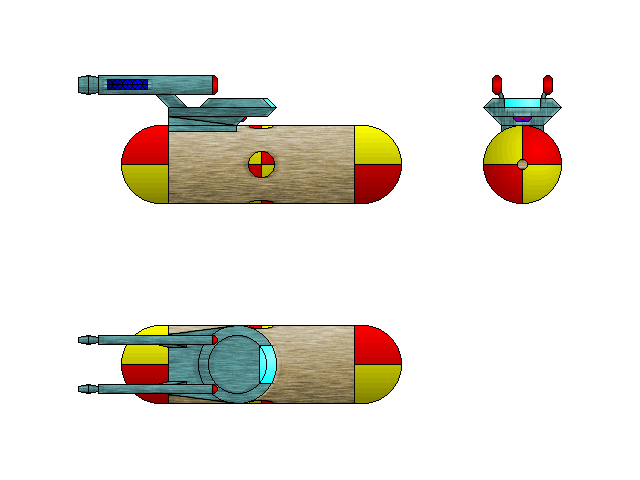
Designer: Robert C. Dunehew E-mail [email protected]

OOaah class Civilian Research Frigate/Bathystat Carrier
"The most exciting phrase to hear in science, the one that heralds the most discoveries, is not "Eureka!", but 'That's funny...' "-- Isaac Asimov
General Specifications (overall):
Length: 97.2m
Width: 23.7m
Height: 38.7m
Max. Warp: 7.85
Cruise: 6
Max. Impulse: 0.5 lightspeed.
Crew: 5 (minimum).
Passengers: Up to 30 researchers. Emergency (short-term) occupancy of up to 200.
Armaments: None.
Specifications (Bathystat):
Length (height): 84.3m
Diameter: 23.7m
Maximum safe dive pressure: 100,000 atmospheres.
Maximum crush pressure: 1,000,000 atmospheres.
Maximum thrust: On-board thrusters (gravitic) provide a total of 5,000 hours of thrust at a continuous output of 5 gravities. This duration will vary depending upon the amount and duration of the thrust.
Type: Civilian Research Frigate/Bathystat Carrier.
Status: 4 in service at this time.
About Ship: The OOah class Research Frigate/Bathystat Carrier was designed to provide a special-purpose vehicle for exploring the dense atmosphere of gas giants. Proposed in the opening days of the Dominion wars, its construction was delayed until the end of hostilities.
The OOaah class (named after a mythical bird that weighs 3 pounds yet lays a five-pound egg) consists of a modified small commercial tug (nicknamed "Momma") and a bathystat laboratory module (the "egg"). The OOaah has sufficient range and speed to deliver the laboratory to anywhere within Federation space in less than a month. When the OOaah arrives on station, the entire vessel descends into the upper atmosphere of the gas giant to be studied, where the tug releases the bathystat. The Tug then assumes geostationary orbit over the region the bathystat was released, to provide telemetry support.
When released, the bathystat uses gravitic thrusters to orient itself with its long axis pointing to the gravitic center of the gas giant, and deploys a large envelope of trans-permeable flexalloy which inflates itself via osmosis. Once the envelope is filled, it forms a large balloon. Low-intensity sonic disruptors mounted at the base of the envelope heat the gases within it, providing static lift, in the same manner as a hot air balloon. The balance between the lift provided by the balloon and the ballast provided by the thrusters is adjusted to ensure that the bathystat will ascend if power to the thrusters is interrupted. The bathystat is designed so that in the event of gravitic thuster failure during initial deployment, the balloon may be deployed in time to prevent the vessel from plunging deeply into the atmosphere of the gas giant where it could be crushed by the pressure.
Once the bathystat is stabilized, the crew aboard begin their mission. Altitude is adjusted to reach whichever atmospheric level the crew intends to study, or to ride a current which travels in a desired direction. Low velocity maneuvering independent of wind currents is achieved by vectoring the gravitic thrusters. At mission's end, the bathystat ascends to the upper atmosphere of the gas giant. It deflates and stores the balloon, while using its gravitic thrusters to hover until the tug can recover it and return to space.
In case of thruster failure, the tug may maneuver to grasp the bathystat while it is still suspended from the balloon. The balloon envelope is then jettisoned, and the combined unit returns to orbit. In an emergency, the gravitic thrusters have sufficient power to directly insert the bathystat into low orbit, should something happen to the tug. An emergency backup system of impulse thrusters is also installed, for the same purpose. The Bathystat possesses life support systems well in excess of its expected requirements, and is equipped with multiply redundant systems in the interest of safety. Artificial gravity provides a normal working environment for the crew even in very high-gravity environments.
Starfleet has expressed an interest in acquiring an example of the OOaah class for its own use (beyond the one currently operated by the Academy). One possible use would be the rescue of a crew from a vessel which has descended within the atmosphere of a gas giant to a depth where it remains statically buoyant. There is at least one instance on public record where this has happened, and the crew is known to have survived for some time before succumbing.
There are currently four OOaah class vessels in operation at this time. All but one were constructed at the Utopia Planitia shipyards at Mars. One is operated (and was constructed under license) by the Vulcan Science Academy and two by Starfleet Academy. The class vessel (the OOaah itself) is operated by the institution which designed it, the Alpha Quadrant Institute of Technology. More may be constructed on an as-requested basis.
Return to the Starship Catalogue.